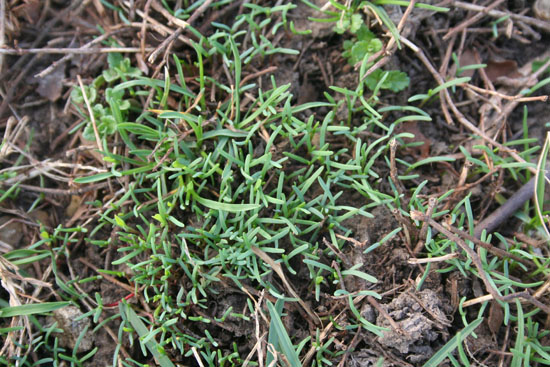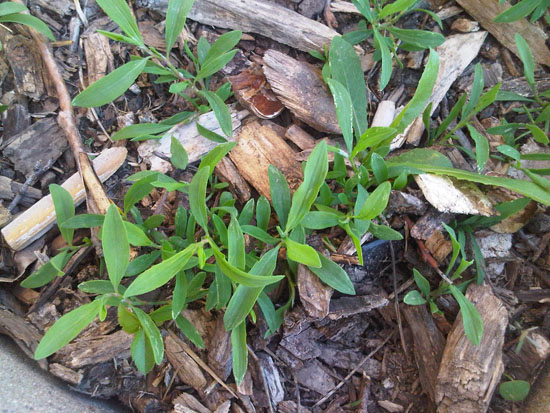Issue 1, April 28, 2014
Prostrate Knotweed -- A Harbinger of Spring
Prostrate knotweed (Polygonum aviculare) is one of the first summer (warm season) annual weeds to germinate, first appearing when soil temperatures are only in the 40's. For this reason, I know that spring has arrived when I see it emerge. Though its subtle beauty is perhaps less appreciated than that of other spring knockouts like magnolias and tulips.
The late Dr. Marshal McGlamery, better known as "Mac", University of Illinois professor of weed science used to always joke about this weed saying, "It's occasionally called knotgrass but it's not grass, it's knotweed!" His jokes were always "punny" -- not the funniest but certainly memorable. And to this day, I'm certain many of his students still know that when knotweed first emerges, it looks like grass. The seed leaves (cotyledons) are very narrow.

Knotweed seedlings.

Knotweed seedlings.
With time, seedlings will grow into a circular mat. Stems can extend up to 2 feet long. They are wiry and tough to pull apart especially if the plant has been growing in droughty conditions. The leaves are dull, blue-green, alternate on the stem, long and narrow (up to 1¼ inch long and ⅓ inch wide). The leaves can appear grayish-green or whitish green when infected with mildew fungi. Being a member of the Buckwheat family, it has a papery sheath (ocrea) surrounding the stem at the leaf base.

Prostrate knotweed.
The flowers are borne in small clusters in leaf axils from June through October but typically go unnoticed due to their small size. The sepals are white to green, with pinkish margins. Seeds then follow which is how the plant reproduces.
Plants can show some purpling after a frost. This is perhaps when they are most attractive and the flowers are most noticeable.
Prostrate knotweed is an indicator of compacted soils and is often found growing in full sun in thin turf or next to sidewalks and driveways where traffic has spilled over. If not for this weed, bare soil would be found in many of these areas. Where I grew up, our grassy farm field drive was mostly prostrate knotweed in many of the areas. I grew up thinking it was a type of grass until Mac told me otherwise.
Prostrate spurge is similar in appearance and in growth habit, however, it has oppositely arranged leaves and the stems exude a milky sap when damaged.
Prostrate knotweed has a thin taproot so hand removal is an option, but best used on young plants growing in moist soil. Tillage can be used and for turfgrass situations, core aerification can be used to get more oxygen to the roots which can aid in growth of grass. Prostrate knotweed tolerates low oxygen levels in the soil.
Postemergent herbicides for controlling this weed in turf include 2,4-D, and dicamba, while preemergent options include pendimethalin and prodiamine. Due to the early arrival of prostrate knotweed, fall preemergent applications are often used. For landscapes, these herbicides may be used: dichlobenil, dithiopyr, isoxaben, napropamide, oryzalin, trifluralin. For more information about these herbicides, consult the Commercial Landscape & Turfgrass Pest Management Handbook available at pubsplus.illinois.edu. Remember to read and follow all pesticide label directions. (Michelle Wiesbrook)
Author:
Michelle Wiesbrook